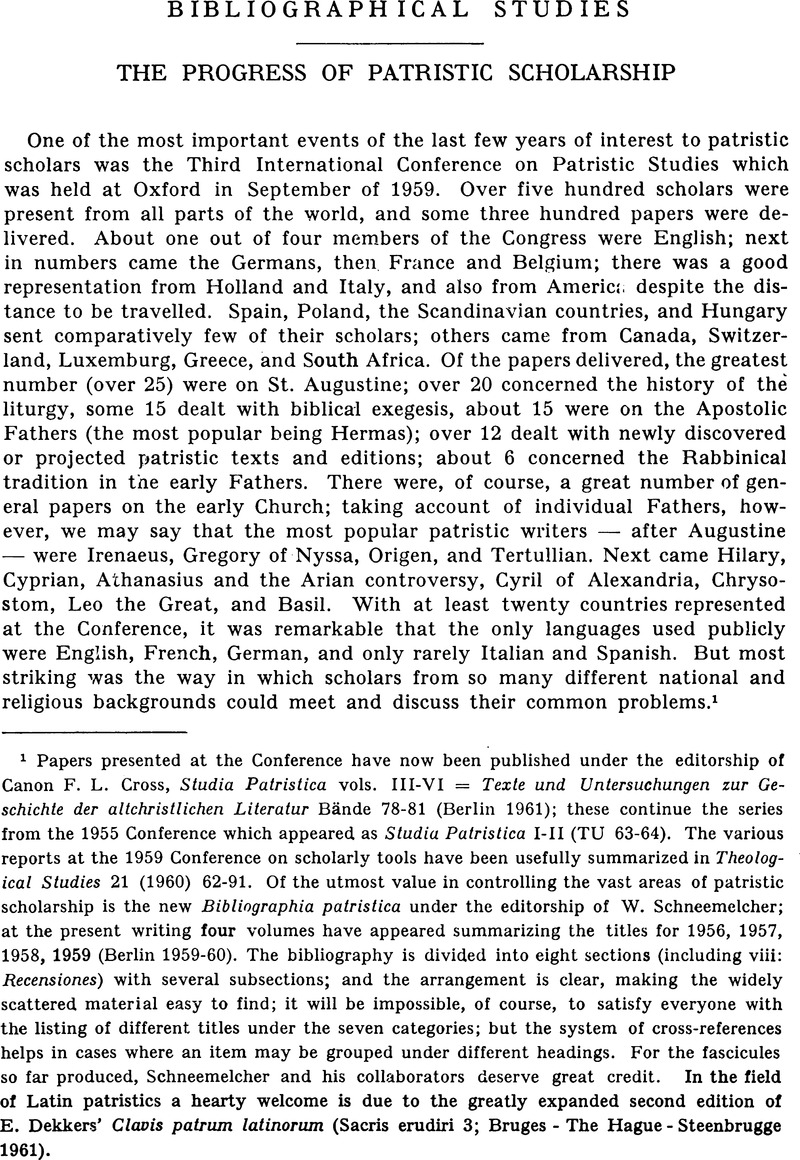Article contents
The Progress of Patristic Scholarship
Published online by Cambridge University Press: 17 July 2017
Abstract

- Type
- Bibliographical Studies
- Information
- Copyright
- Copyright © 1962 New York, Fordham University Press
References
1 Papers presented at the Conference have now been published under the editorship of Canon F. L. Cross, Studia Patristica vols. III-VI = Texte und Untersuchungen zur Geschichte der altchristlichen Literatur B�nde 78-81 (Berlin 1961); these continue the series from the 1955 Conference which appeared as Studia Patristica I-II (TU 63-64). The various reports at the 1959 Conference on scholarly tools have been usefully summarized in Theological Studies 21 (1960) 62-91. Of the utmost value in controlling the vast areas of patristic scholarship is the new Bibliographia patristica under the editorship of W. Schneemelcher; at the present writing four volumes have appeared summarizing the titles for 1956, 1957, 1958, 1959 (Berlin 1959–60). The bibliography is divided into eight sections (including viii: Recensiones) with several subsections; and the arrangement is clear, making the widely scattered material easy to find; it will be impossible, of course, to satisfy everyone with the listing of different titles under the seven categories; but the system of cross-references helps in cases where an item may be grouped under different headings. For the fascicules so far produced, Schneemelcher and his collaborators deserve great credit. In the field of Latin patristics a hearty welcome is due to the greatly expanded second edition of E. Dekkers’ Clavis patrum latinorum (Sacris erudiri 3; Bruges - The Hague - Steenbrugge 1961).Google Scholar
2 Oxford 1961. Fascicle 1 (α-βαραθρόω). For the Latin of the Fathers scholars are less well provided for, though perhaps the need is not as great. Of the many recent, partially incomplete lexicons, we should mention especially J. F. Niermeyer, Mediae latinitatis lexicon minus (Leiden 1954ff.), the fascicles of which cover A - prosecutor at the present writing. For a good bibliography, see in general Robert B. Palmer's edition of Karl Strecker, Introduction to Medieval Latin (Berlin 1957) 20-46. An outstanding example of the Nijmegen school of medieval and patristic Latin studies is Christine Mohrmann, Liturgical Latin: Its Origins and Character (Washington 1957) with bibliography (91-5).Google Scholar
3 Conversion: The Old and the New in Religion from Alexander the Great to Augustine of Hippo (Oxford 1933; reprinted 1952; Oxford paperback edition 1961).Google Scholar
4 The Idea of Reform: Its Impact on Christian Thought and Action in the Age of the Fathers (Cambridge, Mass. 1959).Google Scholar
5 Cambridge, Mass. 1961.Google Scholar
6 The prospectus of forthcoming volumes can be found in the new preface to Contra Eunomium libri pars prior (Gregorii Nysseni Opera I, Leiden 1960) vii-viii. I have been reliably informed that Dr. Hermann Langerbeck of Frankfurt has been appointed to succeed Jaeger as editor of the series.Google Scholar
7 From Glory to Glory: Texts from Gregory of Nyssa's Mystical Writings, selected and with an introduction by Jean Daniélou, translated and edited with annotations by Herbert Musurillo (New York 1961).Google Scholar
8 A useful survey of recent work on the sermons of Augustine is R. J. Deferrari, ‘St. Augustine and His Place in Latin Literature,’ in Teaching Latin in the Modern World, edited by M. R. P. McGuire (Washington 1960) 141-161.Google Scholar
9 Several recent patristic manuals published primarily for the use of theological students were A. Dirksen, Elementary Patrology: The Writings of the Fathers of the Church (Herder 1959), which follows a method of exposition now somewhat outdated, and F. L. Cross, The Early Christian Fathers (London 1960), the first of a projected series of volumes by the competent editor of the Oxford Dictionary of the Christian Church. Cross’ manual, though intended for students, has some fine insights and in general presents a rather broad background with good bibliography (cf. pp. 203-9): the Gnostic papyri are intelligently discussed (31 ff. and passim); and sections on Melito, the creeds, Hippolytus, and Origen reflect recent scholarly opinion.Google Scholar
- 2
- Cited by




